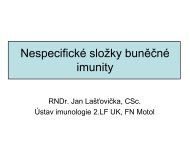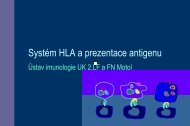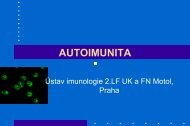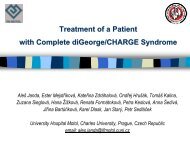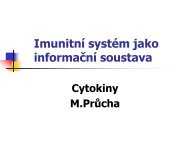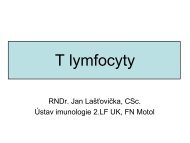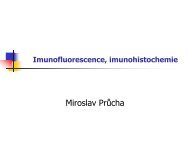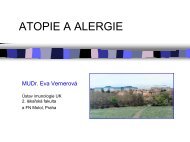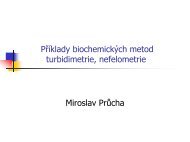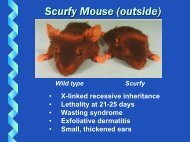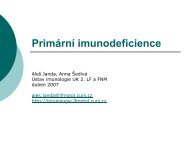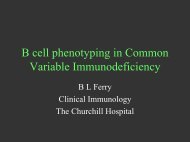V(D)J recombination and its defects
V(D)J recombination and its defects
V(D)J recombination and its defects
Create successful ePaper yourself
Turn your PDF publications into a flip-book with our unique Google optimized e-Paper software.
ESID Prague meeting, 14-15 May 2007<br />
V(D)J <strong>recombination</strong> <strong>and</strong> <strong>its</strong> <strong>defects</strong><br />
Mirjam van der Burg, PhD<br />
Dept. of Immunology Erasmus MC, Rotterdam NL<br />
m.v<strong>and</strong>erburg@erasmusmc.nl
Outline<br />
- V(D)J <strong>recombination</strong> <strong>and</strong> <strong>its</strong> key players<br />
- V(D)J <strong>recombination</strong> <strong>defects</strong> in SCID<br />
- Case report of SCT of Artemis-deficient SCID patient
V(D)J <strong>recombination</strong> of the IGH gene<br />
VH DH JH Cµ<br />
1 2 3 4 5 6 70 1 2 3 4 5 27 1 2 3 4 5 6<br />
V V<br />
D IgH IgH D<br />
J J<br />
V<br />
C C<br />
V<br />
J J<br />
gL IgL<br />
C C<br />
C C<br />
C<br />
C<br />
C<br />
C<br />
CD79b<br />
CD79a<br />
D H to J H rearrangement<br />
translation<br />
VDJ Cµ<br />
transcription<br />
RNA splicing<br />
sµ<br />
+<br />
V H to DH-J H rearrangement<br />
+<br />
mature IGH mRNA<br />
signal joint<br />
BREC<br />
signal joint<br />
BREC<br />
precursor IGH mRNA
V(D)J <strong>recombination</strong> of the TCRB gene<br />
Jβ1 Vβ1 Vβ2 Vβ3 Vβ4 Vβ5 Vβn Dβ1 Cβ1 Dβ2 Vαn Jαn Cα<br />
CD3<br />
ε CD3<br />
δ<br />
CD3<br />
ξ<br />
CD3<br />
ξ<br />
CD3<br />
γ<br />
Cβ2 Vβ4 Dβ2 Jβ2.3 1 2 3 4 5 6<br />
D J rearrangement<br />
V D-J rearrangement<br />
translation<br />
transcription<br />
Jβ2 1 2 3 4 5 6 7<br />
coding joints<br />
Cβ2 +<br />
+<br />
Vβ<br />
1 2<br />
Jβ<br />
D-J signal joint<br />
Vβ<br />
β1 region<br />
V-D signal joint
V<br />
D IgH IgH<br />
V<br />
D<br />
J J<br />
V<br />
C C<br />
V<br />
J J<br />
IgL IgL<br />
C C<br />
C C<br />
C<br />
C<br />
C<br />
C<br />
CD79b<br />
CD79a<br />
TCRα TCRβ<br />
CD3<br />
ε CD3<br />
δ<br />
B-lymphocyte T-lymphocyte<br />
V<br />
J<br />
C<br />
CD3<br />
ξ<br />
CD3<br />
ξ<br />
J<br />
CD3<br />
γ<br />
D<br />
C<br />
V<br />
TCRγ TCRδ<br />
V<br />
J<br />
C<br />
CD3<br />
ε CD3<br />
δ<br />
CD3<br />
ξ<br />
CD3<br />
ξ<br />
J<br />
CD3<br />
γ<br />
D<br />
C<br />
T-lymphocyte<br />
V
Identification <strong>and</strong> isolation of B-cell subsets<br />
CD34<br />
UCB bone marrow tonsil<br />
CD34 +<br />
lin –<br />
CD34 +<br />
CD3/13/19/33/56<br />
CD19<br />
pro-B pre-B-I<br />
CD34 +<br />
CD22<br />
CD34 +<br />
lin –<br />
(defined as:<br />
CD3/13/19/33/56 – CD34<br />
)<br />
+<br />
CD22 +<br />
CD19 –<br />
CD34<br />
CD19 +<br />
CD10<br />
CD34 +<br />
CD19 +<br />
CD10 +<br />
CD20 –<br />
M.C. van Zelm, et al. J Immunol. 2005; 175: 5912-5922.<br />
CD20<br />
pre-B-II<br />
large<br />
CD19 +<br />
SmIgM<br />
CD34 –<br />
CD19 +<br />
CD10 +<br />
CD20 dim<br />
SmIgM –<br />
CD20<br />
pre-B-II<br />
small<br />
CD19 +<br />
CD10<br />
CD34 –<br />
CD19 +<br />
CD10 +<br />
CD20 –<br />
CD20<br />
immature<br />
B<br />
CD19 +<br />
CD10<br />
CD34 –<br />
CD19 +<br />
CD10 +<br />
CD20 hi<br />
SmIgκ<br />
mature-B<br />
SmIg +<br />
κ<br />
mature-B<br />
SmIg +<br />
λ<br />
CD19 +<br />
SmIgλ<br />
CD19 +<br />
CD20 +<br />
SmIg + or SmIg +<br />
κ λ<br />
M.C. van Zelm, et al. J Immunol. 2005; 175: 5912-5922.
IGH gene rearrangements quantified in the B-cell subsets<br />
% rearrangement<br />
100<br />
80<br />
60<br />
40<br />
20<br />
0<br />
DH1-3 - JH1-6 DH4-6 - JH1-6 CD34 + lin –<br />
pro-B<br />
IGH gene complex (14q32.3)<br />
pre-B-I<br />
pre-B-II large<br />
V H(n=66) D H (n=27) J H (n=6)<br />
Cµ<br />
pre-B-II small<br />
immature-B<br />
mature-B<br />
SmIg + κ<br />
M.C. van Zelm, et al. J Immunol. 2005; 175: 5912-5922.<br />
mature-B<br />
SmIg + λ<br />
% rearrangement<br />
100<br />
80<br />
60<br />
40<br />
20<br />
0<br />
VH1-3 - JH1-6 VH4-7 - JH1-6 CD34 + lin –<br />
pro-B<br />
pre-B-I<br />
pre-B-II large<br />
pre-B-II small<br />
immature-B<br />
mature-B<br />
SmIg + κ<br />
mature-B<br />
SmIg + λ<br />
M.C. van Zelm, et al. J Immunol. 2005; 175: 5912-5922.
Summary of the Ig gene rearrangement processes<br />
during precursor-B-cell differentiation<br />
UCB bone marrow tonsil<br />
CD34+ lin–<br />
pro-B pre-B-I<br />
DH-JH M.C. van Zelm, et al. J Immunol. 2005; 175: 5912-5922.<br />
pre-B-II<br />
large<br />
pre-B-II<br />
small<br />
immature<br />
B<br />
VH-DJH Vκ-J κ / Vλ-Jλ in-frame selection<br />
in-frame selection<br />
VH-DJ H rearrangement<br />
mature-B<br />
SmIgκ +<br />
mature-B<br />
SmIgλ +<br />
Kde (Vκ-Kde <strong>and</strong> intronRSS-Kde)<br />
Vκ-Jκ rearrangement<br />
Vλ-J λ rearrangement<br />
M.C. van Zelm, et al. J Immunol. 2005; 175: 5912-5922.
Gene expression profiling of human CD34+lin– <strong>and</strong> precursor B-cell subsets<br />
M.C. van Zelm, et al. J Immunol. 2005; 175: 5912-5922.
Human B-cell Differentiation<br />
0.00002 0.00202 0.01697 0.00035 0.00428 0.00008 RAG1<br />
0.00006 0.00711 0.07780 0.00921 0.02293 0.00660 RAG2<br />
0.04089 0.11344 0.28833 0.53109 2.92265 1.25044 KLF2<br />
0.092622082 0.13030822 0.453499626 0.038315034 0.470261674 0.25391551 KLF4<br />
23.07808182 47.83518 47.5147287 5.928416429 47.47544902 25.65041 COPEB<br />
0.01876 0.015356572 0.048431385 0.02415 0.082380689 0.06453 KLF12<br />
0.04368 0.08391 0.23439 0.00340 0.01599 0.00245 ERG<br />
1.35427 5.02805 4.82170 1.27956 2.86239 1.53144 ETS2<br />
0.25437 0.20236 0.45701 0.01331 0.13964 0.05047 ELK3<br />
10.03955 2.918040688 2.26701 0.90049 15.83723 6.95773 ELF1<br />
0.063379777 0.13444 0.114753471 0.431415906 0.378804284 0.38748 ETS1<br />
0.00009 0.00031 0.0082949 0.10968 0.465429126 0.09816 SPIB<br />
0.02001 0.05201 0.14621 0.02633 0.09111 0.12343 OCT1<br />
0.00009 0.06079 0.11724 0.34472 0.38599 0.10790 OCAB<br />
0.03633 0.01448 0.01080 0.07988 0.26918 0.23847 OCT2<br />
0.00002 0.00000 0.00076 0.00037 0.00628 0.00048 POU4F1<br />
12.10473843 4.773342972 30.75526518 6.50682726 25.73920565 24.89000 SMARCA5<br />
0.000105359 0.00000 0.000380084 0.000971692 0.002059927 0.00129 HIVEP3
EBF, LIG4 <strong>and</strong> RAG1 gene expression in human<br />
CD34 + lin – <strong>and</strong> precursor B-cell subsets<br />
3<br />
2<br />
1<br />
0<br />
-1<br />
-2<br />
12<br />
n=408<br />
CD34<br />
pro-B<br />
pre-B-I<br />
pre-B-II large<br />
pre-B-II small<br />
immature-B<br />
+ lin –<br />
M.C. van Zelm, et al. J Immunol. 2005; 175: 5912-5922.<br />
EBF<br />
LIG4<br />
RAG1
V(D)J <strong>recombination</strong> in detail<br />
1<br />
2<br />
Vκ Vκ<br />
Jκ<br />
coding joint<br />
hairpin<br />
coding ends<br />
opened<br />
hairpins<br />
TdT activity<br />
DNA-PKcs, Ku70/Ku80<br />
<strong>and</strong> Artemis<br />
hairpin cleavage<br />
RAG1/RAG2 complex binds<br />
to RSS DNA cleavage<br />
blunt<br />
signal ends<br />
ligation by<br />
DNA ligase IV, XRCC4 <strong>and</strong> XLF<br />
signal joint
Cell 2006;124:260-262.
V(D)J <strong>recombination</strong><br />
- Initiation by RAG1 <strong>and</strong> RAG2 is lymphoid specific<br />
- Hairpinopening, endprocessing <strong>and</strong> ligation by non<br />
homologous end joining (NHEJ) pathway for DNA ds<br />
break repair (Ku70, Ku80, DNA-PKcs, LIG4, XRCC4, XLF-Cernunnos)
Outline<br />
- V(D)J <strong>recombination</strong> <strong>and</strong> <strong>its</strong> key players<br />
- V(D)J <strong>recombination</strong> <strong>defects</strong> in SCID<br />
- Case report of SCT of Artemis-deficient SCID patient
Severe combined immunodeficiency (SCID)<br />
- Clinical symptoms: opportunistic infections, protracted<br />
diarrhea, failure to thrive, presenting in the first months of<br />
life<br />
- Many causative genetic <strong>defects</strong> have been described<br />
- Immunological classification helpful to search for genetic<br />
defect
T-B-NK+ SCID is caused by defect in V(D)J <strong>recombination</strong><br />
T-B-NK+<br />
T-B-NK+<br />
T-B+NK-<br />
T-B-NK-<br />
T-B+NK+
T – B – NK + SCID<br />
- Approximately 20% to 30% of all SCID patients<br />
- One third of these patients have mutations in the<br />
<strong>recombination</strong> activating genes (RAG1 or RAG2)<br />
- RAG proteins are essential for induction of V(D)J<br />
<strong>recombination</strong> of Ig <strong>and</strong> TCR genes
Flowcytometric analysis of precursor B-cell<br />
compartment in bone marrow<br />
BM PB<br />
Pro-B Pre-B-I Pre-B-II Immature B Mature B<br />
1 2 3 4 5 6 7 8 9<br />
TdT<br />
TdT<br />
ψL<br />
TdT<br />
ψL<br />
ψL<br />
Igµ<br />
Igµ<br />
large small<br />
PreBCR+ PreBCR- smIgM SmIgM/IgD<br />
CD22 CD22 CD22 CD22 CD22 CD22 CD22 CD22 CD22<br />
CyCD79a CyCD79a CyCD79a CyCD79a CyCD79a CyCD79a CyCD79a CyCD79a<br />
CD34 CD34 CD34 CD34 CD34<br />
CD19 CD19 CD19 CD19 CD19 CD19<br />
CD10 CD10 CD10 CD10 CD10<br />
CD20 CD20 CD20
Composition of precursor B cell compartment<br />
in healthy children<br />
average
CyIgµ/SmIgM/CD19 on bone marrow of RAG - SCID
Precursor B-cell compartment in RAG deficient SCID patients<br />
Average
T – B – NK + SCID patients without<br />
RAG gene mutations<br />
- A number of these patients are sensitive to ionizing<br />
radiation<br />
- Causative defect in DNA double str<strong>and</strong> break (dsb)<br />
repair via non-homologous end joining (NHEJ)
V(D)J <strong>recombination</strong> in detail<br />
1<br />
2<br />
Vκ Vκ<br />
Jκ<br />
coding joint<br />
hairpin<br />
coding ends<br />
opened<br />
hairpins<br />
TdT activity<br />
DNA-PKcs, Ku70/Ku80<br />
<strong>and</strong> Artemis<br />
hairpin cleavage<br />
RAG1/RAG2 complex binds<br />
to RSS DNA cleavage<br />
blunt<br />
signal ends<br />
ligation by<br />
DNA ligase IV, XRCC4 <strong>and</strong> XLF<br />
signal joint
Clonogenic survival assay of fibroblasts<br />
after ionizing radiation (Artemis 1,2,3)<br />
% survival<br />
100<br />
10<br />
1<br />
0.1<br />
0.01<br />
0 1 2 3 4 5 6<br />
Dose of X-rays (Gy)<br />
FN1 (wild type)<br />
NBS-1LBI<br />
Artemis-1<br />
Artemis-2<br />
Artemis-3.1<br />
Artemis-3.2
Principle of the V(D)J <strong>recombination</strong> assay<br />
- Transfection of V(D)J <strong>recombination</strong> substrate into<br />
fibroblasts together with RAG1/RAG2<br />
- Wild type fibroblasts<br />
- Artemis-deficient fibroblasts<br />
- Artemis-deficient fibroblasts with wt Artemis or Artemis mutant
Signal <strong>and</strong> coding joint formation in Artemis – patients<br />
signal joint assay coding joint assay<br />
pGG49 pGG51<br />
NV09F<br />
NV08F<br />
FM30 DG147<br />
NV09F<br />
NV08F<br />
FM30 DG147
Signal <strong>and</strong> coding joint formation in Artemis – patients<br />
signal<br />
joints<br />
coding<br />
joints<br />
signal joint assay coding joint assay<br />
pGG49 pGG51<br />
NV09F<br />
sj<br />
NV08F<br />
cj<br />
-Art +Art<br />
FM30 DG147<br />
FN1 control Artemis-1<br />
(deletion exon 10-12)<br />
NV09F<br />
NV08F<br />
cotransfection of RAG1, RAG2 <strong>and</strong> constructs<br />
with (+) or without (-) Artemis<br />
sj<br />
cj<br />
-Art +Art<br />
sj<br />
Artemis-2<br />
(exon 5 G47T)<br />
FM30 DG147<br />
cj<br />
-Art +Art
Composition of the precursor B-cell compartment<br />
in different types of T-B-NK+ SCID<br />
healthy children (n=6)<br />
RAG-SCID (n=7)<br />
Artemis-SCID (n=4)<br />
0% 10% 20% 30% 40% 50% 60% 70% 80% 90% 100%<br />
DNA Ligase IV SCID<br />
pro-B pre-B-I pre-B-II immature B
Composition of DH-JH junctional region in B–/T– SCID patients<br />
DH JH<br />
D H3-3 (germline)<br />
insertion J H4-1<br />
(germline)<br />
GTATTACGATTTTTGGAGTGGTTATTATACC ACTACTTTGACTACT<br />
GTATTACGATTTTTGGAGTGGTTATTATA<br />
GTATTACGATTTTTGGAGTGGTTATTATAC<br />
GTATTACGATTTTTGGAGTGGTTATTATACC<br />
GTATTACGATTTTTGGAGTGGTTAT<br />
GTATTACGATTTTTGGAGTGGTTATTATA<br />
GTATTACGATTTTTGGAGTGGTTATTAT<br />
GTATTACGATTTTTGGAGTGGTTATTATACC<br />
GTATTACGATTTTTGGAGTGGT<br />
GTATTACGATTTTTGGAGTGGTTATTATA<br />
GTATTACGATTTTTGGAGTGGTTATTATA<br />
GTCCA<br />
CGATCG<br />
GGT<br />
CGTAGCGTA<br />
CGTAG<br />
GGCTAAGG<br />
CGGAGC<br />
GGTTC<br />
CGATCGA<br />
CC<br />
TGACTACT<br />
CTTTGACTACT<br />
ACTACTTTGACTACT<br />
TTTGACTACT<br />
ACTTTGACTACT<br />
TGACTACT<br />
TACTTTGACTACT<br />
ACTACTTTGACTACT<br />
CTTTGACTACT<br />
ACTTTGACTACT<br />
1. Assignment of D <strong>and</strong> J gene segments usage<br />
2. Frequency of palindromic (P) nucleotides (caused by asymetric “hairpin” opening)<br />
3. Number of deleted nucleotides<br />
4. R<strong>and</strong>om insertion of nucleotides
Composition of junction regions<br />
DH<br />
3’ deletions<br />
Healthy controls 3.1<br />
P N P<br />
0.2<br />
JH<br />
5’ deletion<br />
Total number<br />
of deletions<br />
5.7 0.3 6.3 9.4<br />
RAG-SCID 4.0 0.2 7.7<br />
0.1 8.1 12.1
Composition of DH-JH coding joints<br />
Healthy controls (15)<br />
DH<br />
3’ del<br />
P N P<br />
RAG-SCID (15) -4.0 0.2 7.7<br />
Artemis-SCID (53) -1.9 3.0 4.0 3.8<br />
JH<br />
5’ del<br />
Total P<br />
-4.2 0.1 7.9 0.1 -6.0 0.2 10.2<br />
0.1<br />
-8.1 0.2 12.1<br />
-1.1<br />
6.7<br />
Total del<br />
3.3
Case report of T-B-NK+ SCID<br />
- Girl form consanguineous parents<br />
- In first year of life no problems<br />
- In second year development of infections of respiratory<br />
tracts <strong>and</strong> c<strong>and</strong>idiasis<br />
- Successively, development of chronic diarrhea <strong>and</strong><br />
failure thrive.<br />
- At 18 months suspicion for immunodeficiency due to<br />
hypogammaglobulinemia<br />
- Improvement with immunoglobulin substitution <strong>and</strong><br />
broad-spectrum antibiotics.<br />
- BMT was initiated, but patient died during conditioning<br />
period
Low numbers of T <strong>and</strong> B cells found in<br />
peripheral blood<br />
Patient Mean<br />
RAG-SCID<br />
Mean<br />
Artemis-SCID<br />
Control<br />
(x10 9 /l)<br />
B cells 0.01 0.001 0.001 0.2-1.6<br />
T cells 0.23 0.2 0.5 0.7-4.2<br />
NK cells 0.5 1.1 1.1 0.09-0.9
Clonogenic survival assay of fibroblasts<br />
after ionizing radiation<br />
% Survival<br />
100<br />
10<br />
1<br />
0.1<br />
0.01<br />
0 1 2 3 4 5 6<br />
Dose of X-rays (Gy)<br />
FN1 (wild type)<br />
Artemis<br />
Patient SC2
Composition of the precursor B-cell compartment<br />
in different types of T-B-NK+ SCID<br />
healthy children (n=6)<br />
RAG-SCID (n=7)<br />
Artemis-SCID (n=4)<br />
Patient SC2<br />
0% 10% 20% 30% 40% 50% 60% 70% 80% 90% 100%<br />
pro-B pre-B-I pre-B-II immature B
Composition of coding joints of patient SC2<br />
Van der Burg et al J. Clin. Invest 2006;116:137
Composition of DH-JH coding joints<br />
Healthy controls (15)<br />
DH<br />
3’ del<br />
P N P<br />
RAG-SCID (15) -4.0 0.2 7.7<br />
Artemis-SCID (53) -1.9 3.0 4.0 3.8<br />
JH<br />
5’ del<br />
Total P<br />
-4.2 0.1 7.9 0.1 -6.0 0.2 10.2<br />
SC2 -12.2 0.2 2.8 0 -16.0 0.1 28.2<br />
0.1<br />
-8.1<br />
-1.1<br />
0.2<br />
6.7<br />
Total del<br />
12.1<br />
3.3
RS-SCID caused by a deletion of three<br />
nucleotides in DNA ligase IV<br />
- First patient with RS-SCID due to DNA Ligase IV<br />
mutation<br />
-Different from described Ligase IV syndrome patients,<br />
because no microcephaly, growth delay<br />
(O'Driscoll M, et al, Mol Cell 2001)<br />
Van der Burg et al J. Clin. Invest 2006;116:137
- A Ligase IV mutation can give rise to RS-SCID<br />
- Clinical spectrum of Ligase IV mutations is broadened<br />
- Can other NHEJ <strong>defects</strong> be expected?<br />
Yes → Cernunnos<br />
Immunodeficiency Microcephaly <strong>and</strong><br />
growth delay<br />
RS-SCID ++ -<br />
Radiosensitivity<br />
LIG4 syndrome + ++<br />
+<br />
Leukemia - -<br />
+<br />
+
Conclusions<br />
- V(D)J <strong>recombination</strong> <strong>defects</strong> result in absence of T <strong>and</strong> B cells<br />
(SCID or growth retardation, microcephaly, <strong>and</strong> immunodeficiency)<br />
- Characteristic block in precursor-B cell differentiation<br />
- V(D)J <strong>defects</strong> can be caused by mutations in RAG1 or RAG2<br />
- If not, fibroblasts are tested for radiosensitivity → if RS, than a<br />
defect is expected in one of the components of NHEJ<br />
- Analysis of DH-JH coding joints gives insight in which step of<br />
V(D)J <strong>recombination</strong> is defective<br />
(Artemis-deficiency: long P – LIG4-deficiency: large deletions)<br />
- Fibroblasts can also be used for in vitro V(D)J <strong>recombination</strong><br />
studies or complementation
The Erasmus MC PID team
Acknowlegdements<br />
Dept. of Cell biology <strong>and</strong> Genetics, Erasmus MC<br />
Nicole S. Verkaik<br />
Dik C. van Gent<br />
Dept. of Toxicogenetics, LUMC, Leiden<br />
Wouter Wiegant<br />
Albert Pastink<br />
Dept. of Pediatrics, Hacettepe University,<br />
Ankara, Turkey<br />
Tuba Turul<br />
Ilhan Tezcan<br />
Dept. of Immunology, The Children’s Memorial Health Institute,<br />
Warsaw Pol<strong>and</strong><br />
Beata Wolska<br />
Malgorzata Pac<br />
Ewa Bernatowska<br />
This work was supported by a grant from the Dutch Cancer Society (KWF, grant EMCR2002-2734)<br />
<strong>and</strong> ZonMw (Veni Grant 916.56.107)
Outline<br />
- V(D)J <strong>recombination</strong> <strong>and</strong> <strong>its</strong> key players<br />
- V(D)J <strong>recombination</strong> <strong>defects</strong> in SCID<br />
- Case report of SCT of Artemis-deficient SCID patient
Differences in outcome of SCT of<br />
B-negative SCID <strong>and</strong> B-positive SCID<br />
- HLA non-identical T-cell depleted SCT are significantly<br />
better for B-positive SCID than for B-negative SCID<br />
(J.Pediatr 1999;134:740-8)<br />
- Reduced survival of B-negative SCID associated with:<br />
- diminished rate in engraftment<br />
- higher frequency of chronic GVHD<br />
- slower recovery <strong>and</strong> lower rate of T/B function
Artemis-deficient SCID<br />
- Female patient diagnosed with SCID at age of 5 months<br />
(failure to thrive, pneumonia due to Pneumocystis carinii <strong>and</strong><br />
CMV infections)<br />
- Agammaglobulinemia, no B-cells, T-cells were of maternal<br />
origin<br />
- At age of 7 months, SCT from HLA-identical brother,<br />
uneventful post-transplantation course<br />
- Gradual rise in T-cells of donor origin, T-cells of mother<br />
disappeared within one year<br />
- However, no B-cell engraftment <strong>and</strong> patient remained<br />
dependent on immunoglobulin substitution
“Lack of Space hypothesis”<br />
No B-cell engraftment post-SCT in B-negative SCID patients<br />
because of lack of physical space in bone marrow due to the<br />
presence of a relatively high frequency of early precursor B-<br />
cells (pro-B <strong>and</strong> pre-B-I), which are not eradicated with mild<br />
pre-SCT conditioning<br />
Van der Burg et al. Hematol 2006; 91:1705-9
Analysis of precursor B-cell compartment at<br />
diagnosis <strong>and</strong> post-SCT<br />
Average
Short t<strong>and</strong>em repeat (STR) analysis<br />
8 11<br />
11 14<br />
patient<br />
donor
Post-SCT all pre-B-I cells of patient<br />
Average
Second SCT<br />
- Artemis-deficient SCID patient received a second SCT<br />
from same donor<br />
- Pre-SCT conditioning with busulphan
B-cell recovery after 2 nd SCT<br />
Average
Post-SCT2 precursor B-cells of donor origin<br />
Average
Conclusion<br />
B-cell recovery after stem cell transplantation of Artemis-<br />
deficient SCID requires elemination of autologous bone<br />
marrow precursor B-cells
Acknowlegdements<br />
Dept. of Immunology, Erasmus MC, Rotterdam<br />
Barbara H. Barendregt<br />
Jacques J.M. van Dongen<br />
Dept. of Pediatrics <strong>and</strong> Central Hematology Laboratory ,<br />
UMC-St Radboud, Nijmegen<br />
Corry M.R. Weemaes<br />
Frank Preijers<br />
Peter Hoogerbrugge



